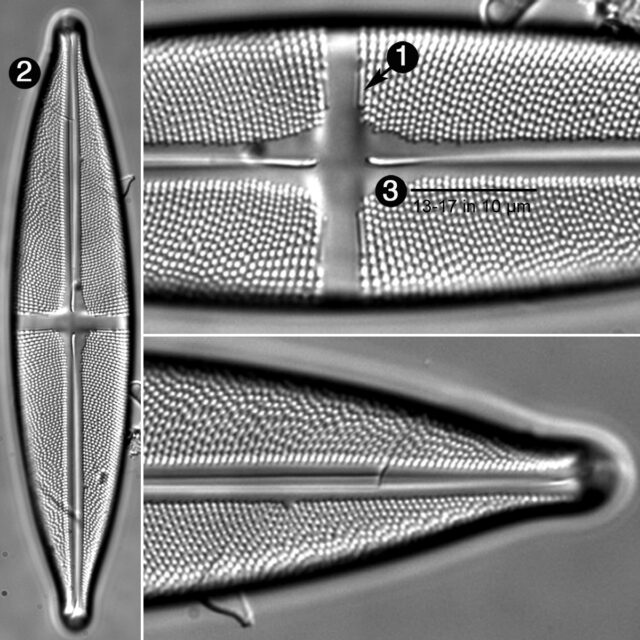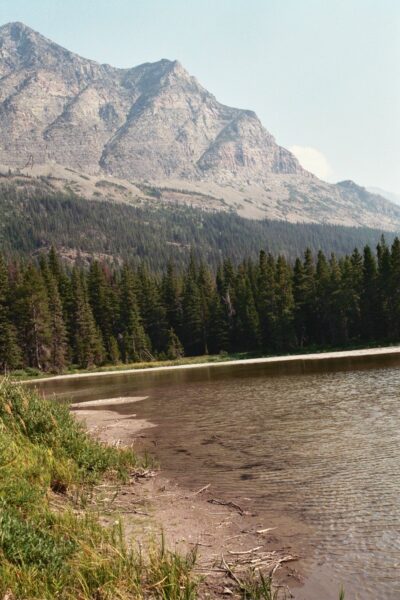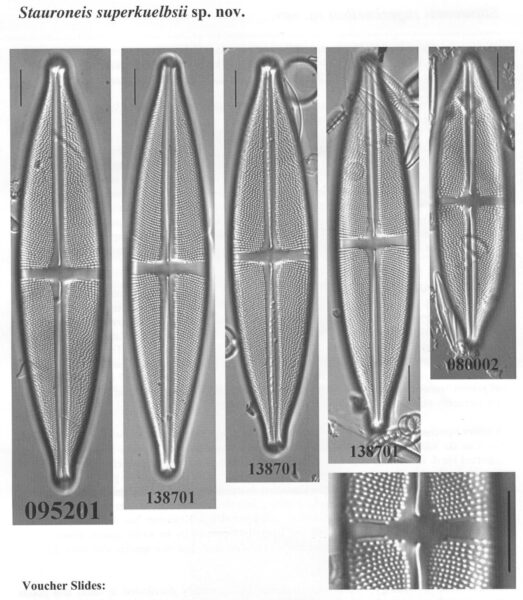Stauroneis superkuelbsii
-
Category
-
Length Range80-156 µm
-
Width Range18-34 µm
-
Striae in 10 µm15-18
-
ContributorLoren Bahls - Dec 2011
-
ReviewerPat Kociolek - Mar 2012
Identification
Description
Valves are lanceolate to linear-lanceolate with subrostrate, broadly rounded apices. The axial area is quite broad, three to four times wider than the raphe, and widens markedly near the central area. The central area is a rather narrow rectangular stauros, hardly expanded toward the valve margins. Short striae are sometimes present at the margins of the central area. Raphe branches are lateral. Proximal raphe ends are curved toward the secondary side and weakly inflated. Striae are curved and radiate throughout, more so towards the apices. Areolae appear relatively coarse and number 13-17 in 10 µm. Areolae are somewhat transapically elongated throughout, and those comprising striae adjacent to the central area are markedly elongated.
Autecology
Stauroneis superkuelbsii is widely distributed in lakes and ponds throughout the Northern Rockies. The pH of these waters ranges from 7.2 to 9.1 and specific conductance ranges from 35 to 465 µS/cm.
-
Size Range, µm3
-
Motility
-
Attachment
-
Habitat
-
Colony
-
Waterbody
- Learn more about this
Original Description
Valves lanceolate to linear-lanceolate with subrostrate, broadly rounded ends. Length 80-156 µm, width 18-30 µm. Length to width ratio: 4.2-5.5. Axial area quite broad, expanding near the central area in a deltoid manner. Central area rather narrow, hardly expanding toward the valve margins. Short striae sometimes present at the margins. Raphe fissures lateral, proximal endings with small pores and curved toward the secondary side. Terminal endings are hooked, also toward the secondary side. Striae curved and radiate throughout, more so toward the valve ends, 15-18 in 10 µm. Striae puncta appear relatively coarse, 13-17 in 10 µm. Foramina of puncta somewhat elongated throughout; those comprising striae adjacent to the central area are markedly elongated. For measurements, n = 32 valves.
-
AuthorBahls 2010
-
Length Range80-156 µm
-
Width18-30 µm
-
Striae in 10µm15-18
Citations & Links
Citations
Links
-
Index Nominum Algarum
Cite This Page
Bahls, L. (2011). Stauroneis superkuelbsii. In Diatoms of North America. Retrieved April 23, 2024, from https://diatoms.org/species/stauroneis_superkuelbsii
Responses
The 15 response plots show an environmental variable (x axis) against the relative abundance (y axis) of Stauroneis superkuelbsii from all the stream reaches where it was present. Note that the relative abundance scale is the same on each plot. Explanation of each environmental variable and units are as follows:
ELEVATION = stream reach elevation (meters)
STRAHLER = distribution plot of the Strahler Stream Order
SLOPE = stream reach gradient (degrees)
W1_HALL = an index that is a measure of streamside (riparian) human activity that ranges from 0 - 10, with a value of 0 indicating of minimal disturbance to a value of 10 indicating severe disturbance.
PHSTVL = pH measured in a sealed syringe sample (pH units)
log_COND = log concentration of specific conductivity (µS/cm)
log_PTL = log concentration of total phosphorus (µg/L)
log_NO3 = log concentration of nitrate (µeq/L)
log_DOC = log concentration of dissolved organic carbon (mg/L)
log_SIO2 = log concentration of silicon (mg/L)
log_NA = log concentration of sodium (µeq/L)
log_HCO3 = log concentration of the bicarbonate ion (µeq/L)
EMBED = percent of the stream substrate that is embedded by sand and fine sediment
log_TURBIDITY = log of turbidity, a measure of cloudiness of water, in nephelometric turbidity units (NTU).
DISTOT = an index of total human disturbance in the watershed that ranges from 1 - 100, with a value of 0 indicating of minimal disturbance to a value of 100 indicating severe disturbance.

Stauroneis superkuelbsii
- Areolae next to stauros extremely elongated
- Valves lanceolate to linear-lanceolate, 80-156 µm long
- Areolae coarse
Stauroneis superkuelbsii has large lanceolate to linear-lanceolate valves that are 80 to 156 µm long. Areolae are somewhat transapically elongate and number 13 to 17 in 10 µm. Areolae adjacent to the central fascia are extremely transapically elongate.
 Diatoms of North America
Diatoms of North America








